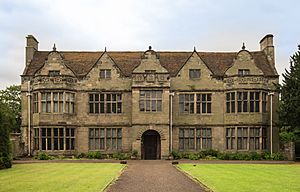St John's House Museum, Warwick facts for kids
 |
|
| Lua error in Module:Location_map at line 420: attempt to index field 'wikibase' (a nil value). | |
| Established | 1960 |
|---|---|
| Location | Warwick, United Kingdom |
St John's House is a very old and important building located in Warwick, England. It has a history that goes back almost 900 years! Today, it's a special place used for learning, events, and even weddings. It is managed by Heritage and Culture Warwickshire.
Next to the house, there is a small garden. Behind it, you'll find the large St. Nicholas' Park. The main building you see today was built around 1666. It is considered one of the most important historic buildings in Warwick.
A Look Back in Time
St John's House has had many different uses over the centuries. It started as a place to help people, then became a home, a school, and even a government office.
As a Hospital
Around the mid-12th century, during the time of King Henry II, the land where St John's House now stands was given for a hospital. This hospital was called the Hospital of St John the Baptist. It was started by William de Beaumont, who was the Earl of Warwick.
This hospital had two main jobs. First, it helped local people who were poor or sick. Second, it offered a place to stay overnight and food for travelers who didn't have much money, like pilgrims. There was another hospital in Warwick at that time, called St Michael's Leper Hospital. It was only for people suffering from leprosy. Today, only the chapel building of St Michael's still stands.
Records from 1291 show that the hospital owned a dovecote, which is a building for doves or pigeons. It also owned land. In 1337, the hospital needed some repairs. People were allowed to collect donations from churches to help pay for these repairs.
By 1610, the hospital site had four buildings. This included a gatehouse with decorative battlements on top. The largest building likely served as the chapel because it had crosses on its roof. The hospital also had a cemetery. Sometimes, when people work on the house today, they still find old remains from the cemetery. For example, in the 1830s, remains were found in the kitchen garden. In 1987, two skulls were found by workmen digging near the front of St John's Court flats.
As a Family Home
During the time of King Henry VIII, many monasteries and religious places were closed down. This was called the Dissolution of the Monasteries. St John's was given to a man named Anthony Stoughton because of his service to the King. His oldest son, William, later inherited the land.
Neither Anthony nor William lived in the house. They rented it out to other people, like Richard Townsende. Eventually, William Stoughton's son, also named Anthony Stoughton, inherited the land. He built a new house on the site. You can still see a door frame in the East Wing of the house with the date 1626 and the initials "A.S." The Stoughton family owned the house until 1960.
As a School
In 1791, St John's House was rented out for the first time for public use. The plan was to turn it into a school. The school was called St John's Academy and was started by William T Fowler. It was advertised as a school for "Young Gentlemen."
Later, in 1845, Benjamin Townsend, who was William Fowler's son-in-law, took over the school. After Benjamin died in 1857, three of his daughters, Susanna, Elizabeth, and Sarah, ran the school. From at least 1861, it became a girls' school.
As a Public Building
After a short time as a private home in the early 1900s, the house became the property of the War Department. This means it was used by the military for administrative work.
In 1959, the Lord Warwick decided to sell the Warwick Castle Estates, which included St John's House. The building was then turned into a museum. Some parts of the building were rented to the Royal Warwickshire Regiment. The museum officially opened in 1960. It was opened by a famous military leader, Bernard Montgomery, 1st Viscount Montgomery of Alamein. The museum stopped being open to the public in 2016.
What's Inside the House Today
When St John's House was a museum, it had exhibits about its own history, as well as the history of Warwick and the surrounding area. Some of the interesting things it featured included:
- A Victorian Classroom: There was a full-sized copy of a classroom from the Victorian era. This showed what a school would have looked like when St John's House was a school. It had old benches, charts, and teaching tools like abacuses and blackboards. This display helped young people understand how different education was in the 1800s compared to today. The house still runs activities based on this exhibit for schools.
- Military Museum: The second floor used to have a museum dedicated to the history of the Royal Warwickshire Fusiliers. This military museum moved to Pageant House Warwick in 2021.
- Outdoor Gardens: In 2011, the museum created a special outdoor area called St John's Brook Gardens. This space was between St John's House and St Nicholas' Park. It featured woodcarvings and information about nature.
Today, the museum is no longer open to the general public for daily visits. It is now the home of Warwickshire Heritage Learning. It also hosts special events and can be rented for different occasions.
See also

